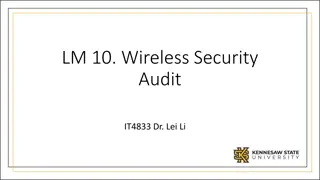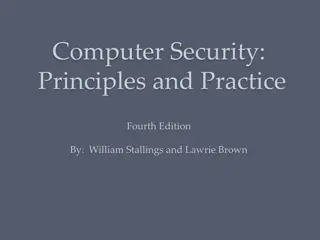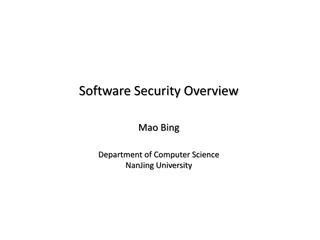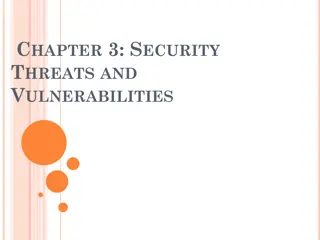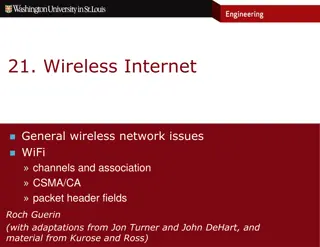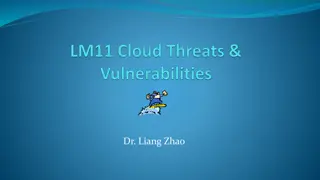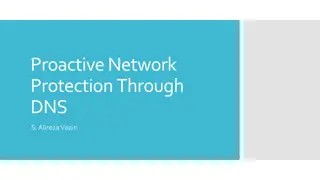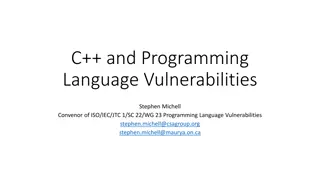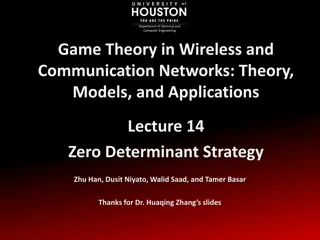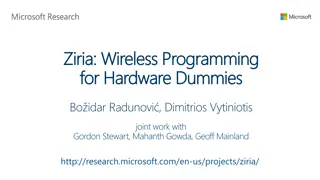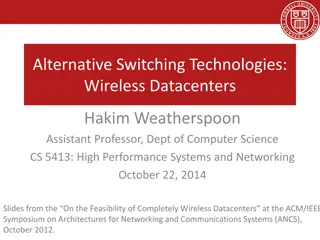Understanding Wireless Network Threats and Vulnerabilities
Explore the various threats and vulnerabilities present in wireless networks, including different types of attackers, weaknesses in WLAN security standards, such as WEP, and the risks associated with Bluetooth and Ad Hoc networks. Learn about the profiles of cyber attackers and the importance of implementing proper security measures to protect against potential breaches and attacks.
Download Presentation

Please find below an Image/Link to download the presentation.
The content on the website is provided AS IS for your information and personal use only. It may not be sold, licensed, or shared on other websites without obtaining consent from the author. Download presentation by click this link. If you encounter any issues during the download, it is possible that the publisher has removed the file from their server.
E N D
Presentation Transcript
LM 4. Wireless Network Threats & Vulnerabilities Dr. Lei Li
Road Map Mobile Security Security Auditing & Risk Analysis WLAN Security Introduction Mobile Network Overview Evolution of Wireless Network WLAN Overview Cellular Network Security Infor. Security Essentials WLAN Threats & Vulnerabilities Mobile Security Threats WLAN Security WLAN Mobile Devices Security Security Tools 2
Learning Outcomes After this module, a student will be able to: Describe different types of attackers Describe the vulnerabilities of WLAN in general Describe WEP, WPA and WPA2 and their vulnerabilities. Explain what s passive attack and what s active attack. List two examples of each types attack. Describe confidentiality, access control, availability, authentication and integrity attacks on WLAN. Discuss Bluetooth security features Describe Bluetooth vulnerabilities and threats Describe the threat models of the Ad Hoc wireless network 3
General Profiles of A Cyber Attacker Attacker Example Script Kiddie/Skid only partially engagedin understanding offensive tools Expert Attackers Kevin Mitnick, curiosity, money, patriotism,etc. Activist/Hack tivists Anonymous Nation States Stealing, Disrupting Services Logic Bombs, support law enforcement & military Terrorists ISIS Defacement ofUS disabled Veteran websites, DDoS of power grids, Chemical Changes in Water Motive Action People interested in or Curious, Mischievous, Street Cred Since they don t know the tools they may be very noisy when attacking and perform a lot of attempts, may have the most harmful consequences Only limited by their imagination, can steal, spy, and sell exploits on the unethicalmarket @th3j35t3r, EdSkodus, Various motives, Manning,Snowden, Further a Cause Reveal Information, further a cause, deface websites, or disrupt progress of opposition Gain a greater understanding of allies andenemies Stuxnet Espionage: Further a Cause Infiltrate, destroy data, cause political upheaval, death, manipulate data in order to promote a cause Cybercrime Mafia Money DOS against financial institutions, steal credentials, sell illegal goods, anything for money, Crime as a Service (CaaS), Ransomware variants, credit card theft, etc. Destruction of data, altering data, or stealing information Insider Attacker Current or Former Employee Revenge, could be clueless employees too
WLAN Vulnerabilities WLAN-Flexibility, cost-effectiveness, & easy of installation Use of Radio Frequency Difficult to contain the signals Vulnerabilities in security standards Easy to setup often means more network not properly configured for secure access 5
Security Standards WEP (Wired Equivalent Privacy) Created in 1999 by IEEE 802.11b Provide same level of privacy as that of wired LAN 40/104 bit key are static & IV is short No effective key management Encryption algorithm (RC4) Known flaws Easy target for cryptanalysis Shouldn t be used in today s WLAN 6
Wi-Fi Protected Access (WPA) Developed in 2004 by 802.11i to address issues of WEP Use 48bits TKIP Add Integrity protection Enterprise and personal mode Enterprise mode use EAP and 802.1x for access control and authentication Backward compatible with old device employs WEP Still uses RC4 Vulnerable to dictionary, brute force, and DoS attacks 7
WPA2 Successor to WPA, ratified by IEEE 11i in 2004 Most secure security standard available Replace RC4 & TKIP with AES and CCMP for encryption and authentication More seamless roaming Still have vulnerability 8
Enterprise Mode Vs. Personal Mode Exist in WPA & WPA2 Same encryption algorithms Different authentication method Enterprise mode 802.1x, designed for organizations Personal mode pre-shared keys, designed for home use 9
Wireless security cheat sheet http://searchnetworking.techtarget.com/feature/Wireless-encryption-basics- Understanding-WEP-WPA-and-WPA2 10
Attacks to WLAN Passive attack Traffic analysis Active attack Unauthorized access Rogue access point 11
Confidentiality Attacks Traffic analysis Eavesdropping Man-in-the-Middle attack Evil Twin AP 12
Access Control Attacks War driving Rogue access point MAC address spoofing Unauthorized access 13
Integrity Attack Session hijacking Reply attack 802.11 frame injection attack 802.11 data replay attack 802.11 data deletion 14
Availability Attacks DoS/ Queensland DoS RF Jamming 802.11 beacon flood 802.11 association flood 802.11 de-authentication Fake SSID EAPOL flood AP theft 15
Authentication Attack Dictionary & brute force Shared key guessing PSK cracking Application login theft Etc. 16
Bluetooth Security Security mode 1 Security mode 2 Security mode 3 Security mode 4 17
Bluetooth Threats & Vulnerabilities Vulnerabilities Encryption key length negotiate No user authentication Much more Threats Bluesnarfing Bluejacking Bluebugging Etc. 18
Ad Hoc Wireless Network Threats Internal threats External threats Routing threats 19
Reference Praphul Chandra, Bulletproof Wireless Security: GSM, UMTS, 802.11, and Ad Hoc Security, ELSEVIER, 2005. Jim Doherty, Wireless and Mobile Device Security, Jones & Bartlett Learning, 2016. https://www.walshcollege.edu/upload/docs/CyberSpring/Profile%20of%20a %20Cyber%20Attacker%20Presentation.pdf https://thesai.org/Downloads/Volume5No1/Paper_25- Wireless_LAN_Security_Threats_Vulnerabilities.pdf http://nvlpubs.nist.gov/nistpubs/Legacy/SP/nistspecialpublication800- 121r1.pdf https://www.utc.edu/center-information-security-assurance/pdfs/course- paper-5620-ad-hoc-security.pdf 20






